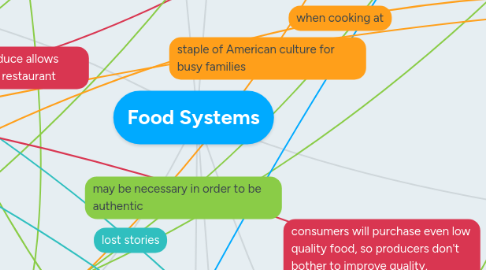
1. food effects
1.1. obesity
1.1.1. body image
1.2. drowsiness
1.3. energy
1.4. birth defects
1.4.1. anti-cancer properties
2. food processing
2.1. foreign countries
2.1.1. culture
2.1.2. cultural misconceptions
2.2. no tracking/ trace system
2.3. uninspected sites
2.4. Haber-Bosch
2.5. FDA regulations
2.6. history of corn
2.7. bananas extinction
2.8. mass production
2.9. food quality
3. eating habits
3.1. comfort foods
3.2. consistent food groups
3.3. growing up with food
3.4. developing new tastes
3.5. entomophagy
3.6. pickiness
3.6.1. depression
3.7. poverty
3.7.1. eating when possible
3.7.2. conditioning
3.8. overconsumption
3.8.1. consumer culture
3.9. location
3.9.1. home
3.9.1.1. kitchen table
3.9.1.2. floor
3.9.2. out to eat
3.9.3. with friends
3.10. ready-to-eat meals/'TV' dinners
4. Economics
4.1. marketing campaigns
4.2. branding
4.3. supply/demand
4.4. pricing
4.4.1. competition
4.5. bulk purchasing
4.6. conglomeration
5. health marketing
5.1. nutrion labels
5.2. marketing schemes
5.2.1. provenance
5.2.2. mislabeled products
5.2.2.1. higher prices
5.3. organic food
6. authentic food
6.1. Americanized
6.1.1. origins based on rate of immigration
6.1.2. lack of resources
6.1.3. aesthetics
6.1.4. taste preference
6.2. why is rice so prevalent in asian and spanish foods?
6.3. origins of certain ingredients?
6.4. what makes it authentic?
6.4.1. preparation
6.4.2. technique
6.4.3. presentation
6.4.4. staged authenticity
6.4.4.1. tourism
6.4.4.1.1. Maslow's Hierarchy
6.5. fast foods
6.5.1. frozen-processed foods
6.6. restaurants
6.6.1. chain restaurants
6.6.2. family owned restaurants
6.7. style restuarants
6.8. authentic restaurants
6.9. fusion restaurants
7. Farmers
7.1. competition w/ large corporations
7.1.1. organic
7.2. stands/ markets
7.2.1. no middle man
7.2.2. customer feedback
7.3. low production price
7.3.1. high retail price
7.4. high production rate
7.4.1. low quality, mass-produced ingredients
7.4.2. Food surplus
7.5. crop variety
8. Buying Habits
8.1. Pricey food
8.2. cheap/cost-effective food
8.3. buying less
8.4. buying for novelty
8.5. buying because of familiarity
8.5.1. impacts market investment

